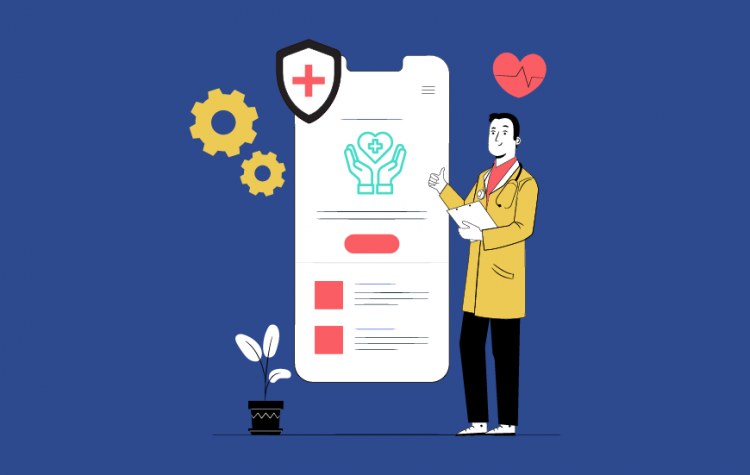If you are grappling with the question of how to improve productivity in healthcare, then you should know that health systems, payers, and the life sciences industry are increasingly contacting healthcare services and technology (Healthcare services and technology ) providers for seeking help in identifying inefficient spending and boosting profits and productivity.
Healthcare services and technology enterprises have been doing this for a while. They have improved the capacity for strategic thinking to derive a variety of solutions to common problems faced by the sector with the benefits of big data in healthcare. Health service outsourcing contributes to increased productivity in the healthcare industry in a number of ways, including the development of payment choices, logistics, and data and software platforms.
Now let’s look in detail at what is big data analytics in healthcare? How data analytics is used in healthcare settings, and how healthcare services and technology companies can boost productivity with data analytics.
Along with these, we will also be looking into the characteristics of successful healthcare services and technology companies and evaluation criteria to determine the success of healthcare services and technology companies. Let’s begin!
Characteristics of successful healthcare services and technology companies
Successful healthcare services and technology businesses tend to share the following traits:
- First, they are prepared to assume risk and share responsibility for results.
- Second, the businesses exhibit a genuine desire to invest and have the skills necessary to maximize the return on those investments, enabling them to keep up with the continuously evolving healthcare landscape.
- Third, successful businesses have been able to use their skills and knowledge across the value chain, allowing them to provide services to players who are becoming more integrated.
The presence of these characteristics, among others, makes healthcare services and technology companies succeed.
What is big data analytics in healthcare?
The healthcare sector produces a lot of data, but it has a hard time turning that data into insights that enhance health outcomes and process efficiency. The goal of data analytics in healthcare is to assist providers in overcoming barriers to the extensive use of data. They do this by –
- Enhancing the availability and usability of big data and healthcare so that it may be shared with colleagues, external partners, and the general public and made easier to understand
- Supplying healthcare providers with accurate information in real time so they can respond to changing healthcare markets and environments more quickly
- Healthcare businesses may enhance data collaboration and innovation to transform analytics-ready data into business-ready data by automating low-impact data management procedures.
How data analytics is used in healthcare settings?
Every facet of patient care and operational management in the healthcare industry can benefit from the use of data analytics. It helps to look into ways to provide better clinical care, enhance illness prevention, and measure the efficacy of various treatment choices with the help of data science in healthcare. These areas of healthcare are anticipated to be most affected by data analytics’ capacity to transform unprocessed healthcare information into useful insight:
What are the types of Healthcare Data Analytics?
Healthcare analytics come in a variety of forms. The following are the most popular data analytics subcategories in health care:
- Descriptive analytics: In order to get insights into benchmarks as well as trends, descriptive analytics in the healthcare industry leverages historical patient data.
- Prescriptive analytics: Machine learning is used by prescriptive analytics to suggest a course of action.
- Predictive analytics: Predictive analytics is a technique used in the healthcare industry to estimate and simulate likely future events.
- Discovery analytics: Discovery analytics also makes use of machine learning, just as prescriptive analytics. The distinction is that it makes use of machine learning to analyze clinical data in order to find patterns that offer useful insights.
Each of these types of healthcare analytics uses a different analytics technology. These data analytics have real-world applications that can help patients and healthcare organizations.
How healthcare services and technology companies can boost productivity with data and analytics
Here, we concentrate on five areas where healthcare services and technology organizations may make investments to better serve their consumers and turn masses of big data analytics in healthcare into insights and strategy, thereby increasing their productivity and enhancing customer experience.
1. Healthcare services and technology companies should make an investment in accessing diverse healthcare data
Access to various data sources is one of the essential requirements for companies offering healthcare services and technologies. The analytical talents that healthcare IT companies frequently employ would be useless without obtaining the primary data sources. Data’s diversity—its quantity, kind, and variety—is what makes it so distinctive.
The data’s diversity and high quality increase the chance of providing fresh insights. Due to divisions and compartmentalization, many firms still struggle with large-scale integration while having access to a huge bulk of data. Additionally, this makes it challenging to develop efficient plans of action and insights. It could also make it challenging to draw conclusions. Vendors might begin compiling a thorough picture of overall spending and strategies for lowering it using both primary and auxiliary sources of data. Let’s examine how
- Primary data sources: The information from e-medical records, claims, labs, and pharmacies, forms the basis of the typical patient picture. These data serve as the basis for precise and reliable insights into the individuals and the categories of the data.
- Supplementary data sources: Patient-reported experiences, social determinants of health (SDoH), contract data, and consumer-coverage data, among other sources, can be used to provide a comprehensive state of the patient that takes into account factors beyond the traditional healthcare system. These are the additional sources of information.
For instance, a healthcare services and technology provider in the market for risk-adjustment services might analyze claims data and e-health records to create patient-level risk profiles and then combine SDoH and behavioral-health data to create even more comprehensive risk profiles for individual patients.
2. Healthcare services and technology companies should concentrate on data aggregation for member records
Healthcare institutions must gradually develop a thorough understanding of each patient’s background, a centralized repository of truth, along with an overarching picture of that patient. For example, data that was taken at a crucial moment between patient and doctor can be gathered and carefully analyzed to create information.
To supply the data-aggregation service, it is often crucial to link and enhance the variety of big data in healthcare sources that healthcare services and technology vendors have. Collecting and methodically analyzing complex data and expanding the breadth of analysis of unstructured data can be expected as a result of the development of scalable, centralized, and practical big data in healthcare platforms.
For instance, using patient-recognition technologies to bring together datasets, pre-packaged analytics, and common data models can all improve the effectiveness and quality of insight creation. By bringing down the transactional barrier between analytics and data and generating more insights, platforms for big data analytics in healthcare and analytics may further encourage innovation.
Despite the fact that healthcare services and technology providers may be able to supply their clients with effective approaches and insights within the constraints of the present connection norms and frameworks, healthcare organizations continue to seek comprehensive interoperability when it comes to data aggregation. Healthcare services and technology suppliers may put a priority on effortlessly bringing together data from various internal and readily available third-party data sources prior to actually tackling more challenging interoperability challenges. By removing the current internal obstacles, it will be easier to develop solutions for the upcoming interoperability problems.
3. Healthcare services and technology companies should invest in advanced analytics
To transform big data analytics in healthcare into actionable insights, predictive and advanced analytics methods are needed, including machine learning for predictive modeling, natural language analytics, a mixing of data mining across several datasets, and automated insight generation via embedded platforms. Healthcare services and technology providers may need additional specific advanced analytics determined by the type of business or marketing objectives they are striving for.
Healthcare mobile app development companies must be capable of consuming and modifying data from a range of channels, including digital claims processes, paper medical records, and internet-scraped data, in order to deliver analytics to core sets of data. Top Healthcare services and technology providers are also continuously collecting and translating enormous amounts of data. To assess the legitimacy of probable payments, they might, for instance, develop an easily available feedback mechanism for a health sciences company or conduct real-time analysis of huge data sources for a payer.
4. Healthcare services and technology companies should invest in a multidisciplinary background and expertise
Organizations associated with the payers, life sciences, and health systems depend on healthcare services and technology providers for more than just access to data and analytical power. An “enterprise content library,” which would boost market and sector awareness, knowledge, and understanding of the healthcare sector, might be created by combining data analytics in healthcare and insights.
Vendors in an isolated environment may overlook trends and insights that suppliers in an interconnected model will require to be able to recognize. This ability calls for not only obtaining data accessibility but also gaining specialized knowledge and perceptions of the various business sectors that Healthcare services and technology providers serve.
For example, in the case of payment or financial integrity issues, many providers look into the claims process for payment issues. Integrating medical data analytics in healthcare to a payer’s claims stream in this assessment entails translating physician advice to detect ineffective therapies or incorrect prescription doses. Few Healthcare services and technology organizations actually possess the know-how to link payment data with evaluations of quality and risk. One of the most important ways to differentiate one service from another involves the capacity of providers to consistently update regulations based on evolving medical standards as well as provide corroborating data.
5. Healthcare services and technology companies should work towards workflow integration
Workflow integration is one of the important areas where Healthcare services and technologies should invest in. This enables perceptions of typical business activities to solidify as essential business procedures. The clients are more inclined to act when insights are accurate and useful. It will be less fruitful if insights are not included in a customer’s personnel’s workflow, preferably at the click of a screen. Moreover, employees also place a higher value on solutions that can seamlessly integrate information into workflows as well as business processes.
Evaluation criteria to determine the success of healthcare services and technology companies
Companies operating in the quickly expanding big data and healthcare services and technology market must evaluate themselves in light of five key considerations as the market develops. If your company provides data science in healthcare services and technology, you should use the following questions to gauge if it can be qualified as a top healthcare analytics company as well as where it stands in relation to the competition.
1. Have you coordinated your company’s growth strategy with the relevant healthcare services and technology sectors of the economy, keeping in mind that various subsegments will expand at distinctly different rates and necessitate special capabilities? What wagers does your strategy make on a successful product-market business model?
2. Who is or will be paying for your services in the end? What advantages do they gain? How much will they get back? What impact may time and other factors have on the value? How does this fit into their criteria for purchasing? Are you willing to share the risk of achieving the desired results with your clients?
3. Have you created a winning platform strategy in fields where you could benefit from growth trends? How will you implement this tactic to multiply your consumer base by 10, 20, or even 100? What strategy do you have to expand in an area that is getting more crowded?
4. How do you intend to set yourself apart from rivals (for instance, by working on the above-mentioned game-changing technology) in order to attract and keep specialized talent? Are you prepared to grow and operate in an “agile mode” across all of your business processes, especially those where you might need to make up for customer or partner capacity gaps?
5. Does your company promote a culture that is centered on insights? Are you able to use your big data analytics in healthcare to its fullest potential in order to improve performance, market focus, and customer intimacy?
Conclusion
Any healthcare services and technology vendor, whether its intended audience is health systems, payers, life sciences companies, or all three, must integrate the aforementioned five competencies. A vendor may use these competencies along with data science in healthcare to generate new revenue streams, increase its present revenue streams, or do both by diversifying into nearby market sectors or going deeper with its current clients with the help of the use of big data in healthcare. These will also take into account data and analytics to boost productivity for technological companies in the healthcare system.
Healthcare services and technology companies are currently at a turning moment with respect to big data and healthcare, with questions of how technology can improve productivity surrounding them. Due to rising competition, data availability, market demands, and complexity, significant investments in digital technology and capabilities of data analytics in healthcare are now necessary. Top officials of leading healthcare services and technology companies must now actively cultivate apps to boost productivity with the help of digital technology as well as data analytics in healthcare capabilities if they want to maintain and improve their competitive advantage and enhance productivity in the overall healthcare sector.
Written By
She is a content marketer and has more than five years of experience in IoT, blockchain, Web, and mobile development. In all these years, she closely followed the app development, and now she writes about the existing and the upcoming mobile app technologies. Her essence is more like a ballet dancer.
Want To Hire The Best Service Provider?
MobileAppDaily will help you explore the best service providers depending on your vision, budget, project requirements and industry. Get in touch and create a list of best-suited companies for your needs.
Source by www.mobileappdaily.com



















